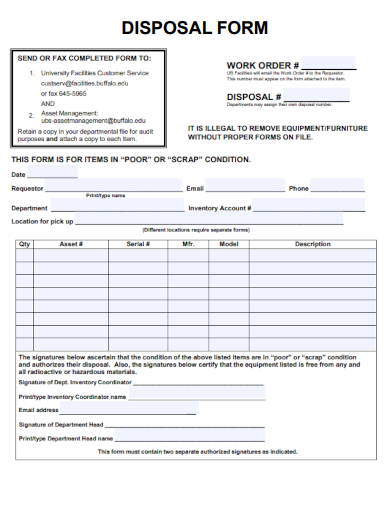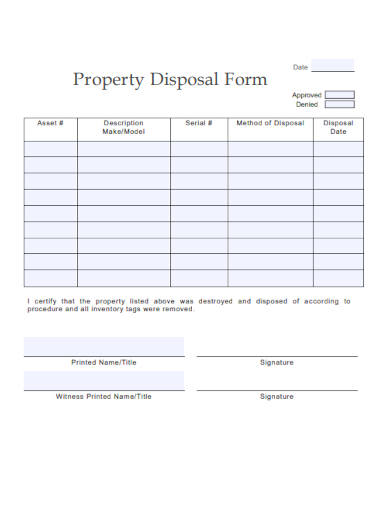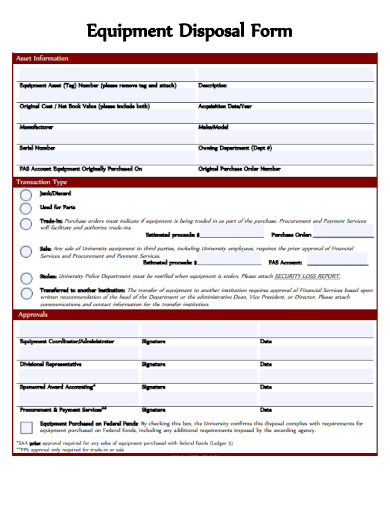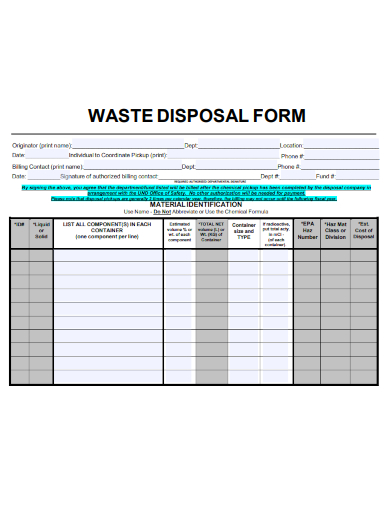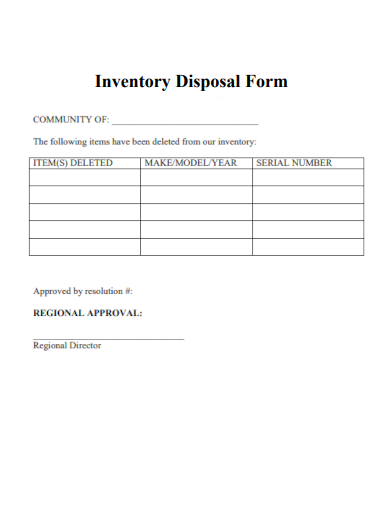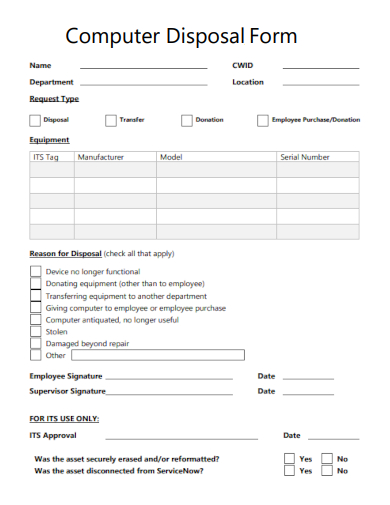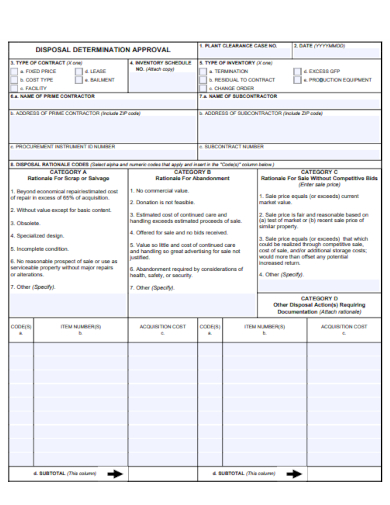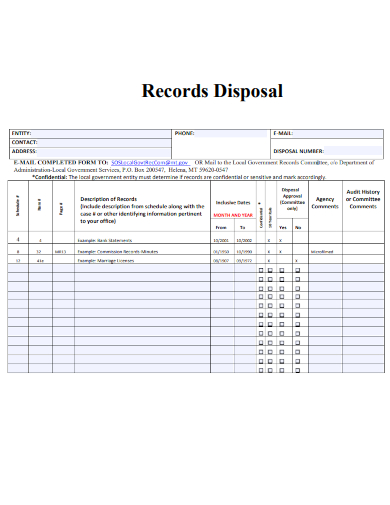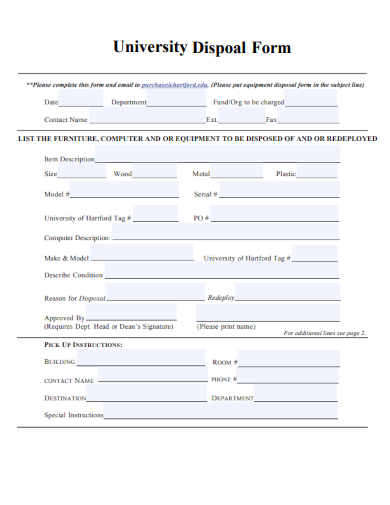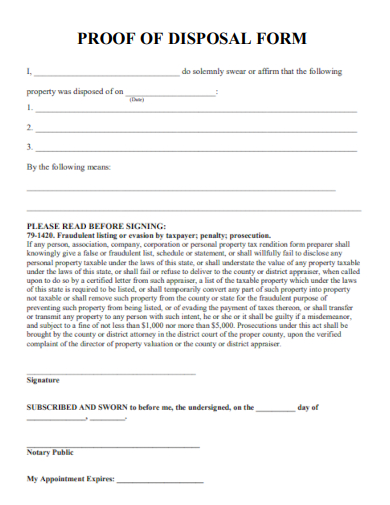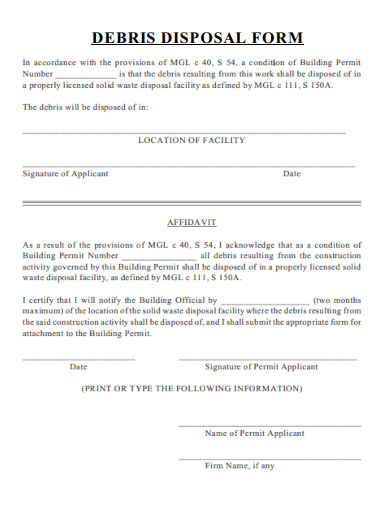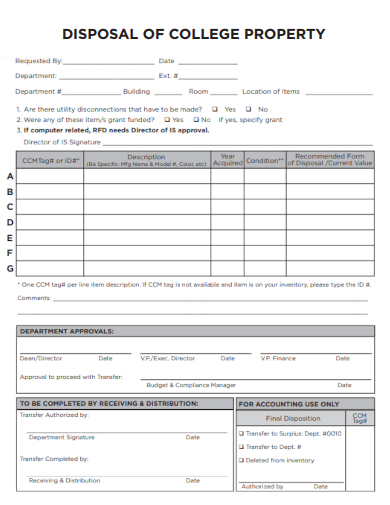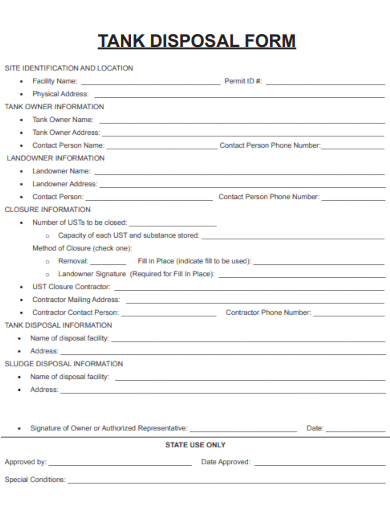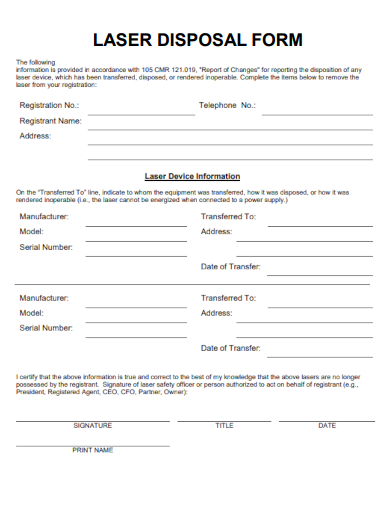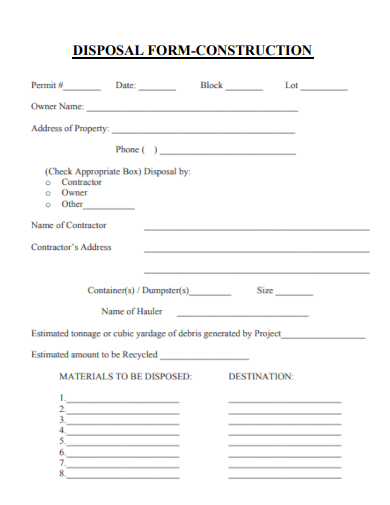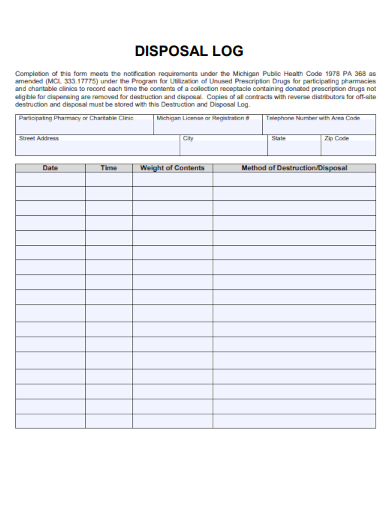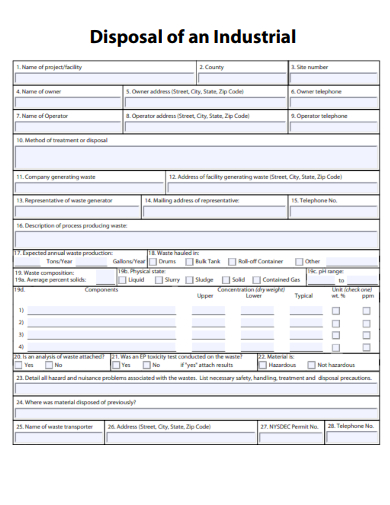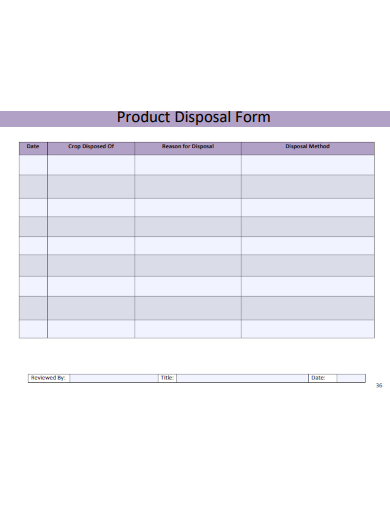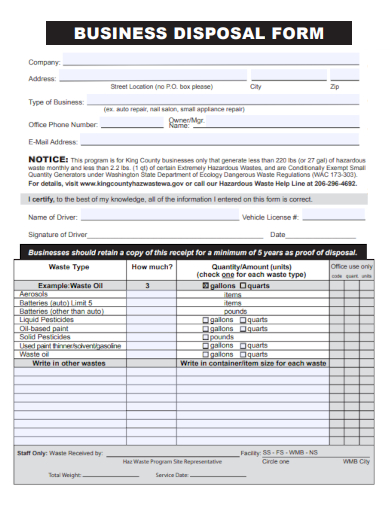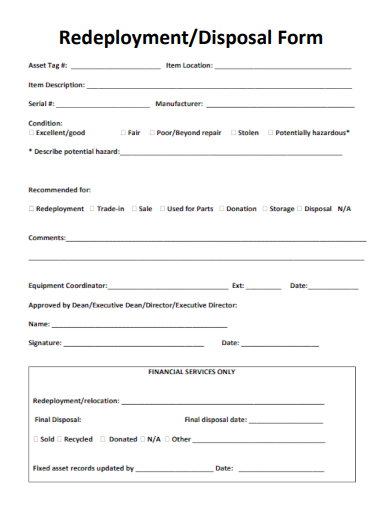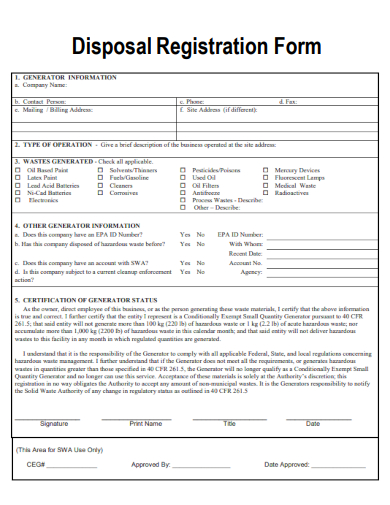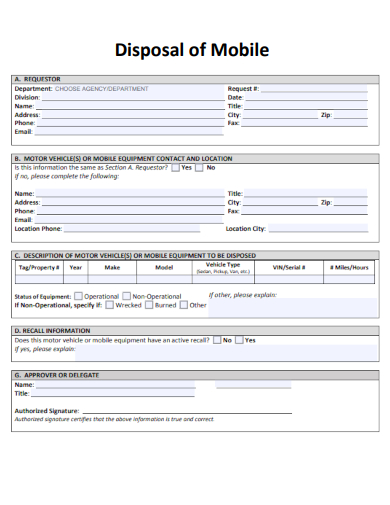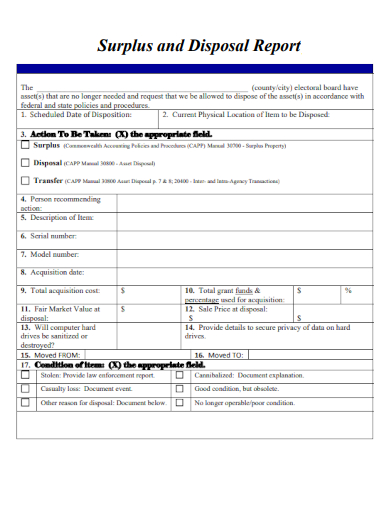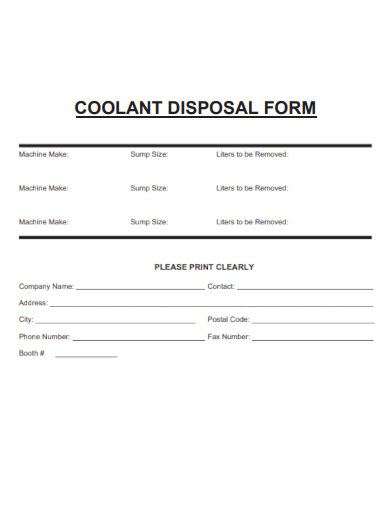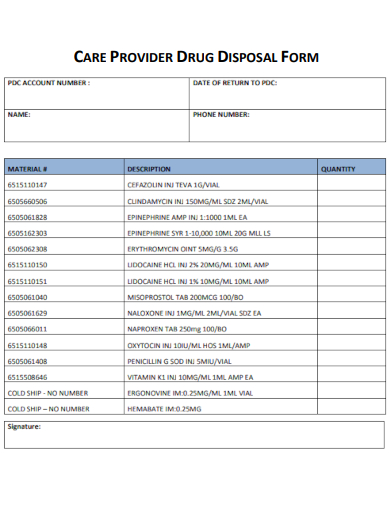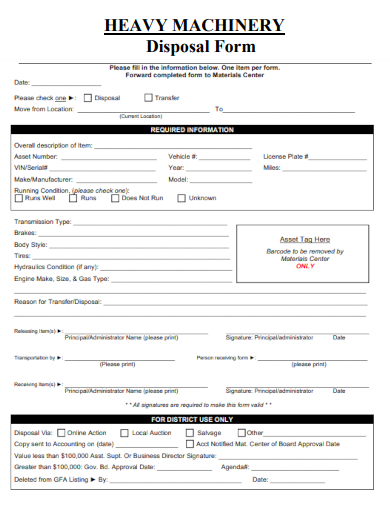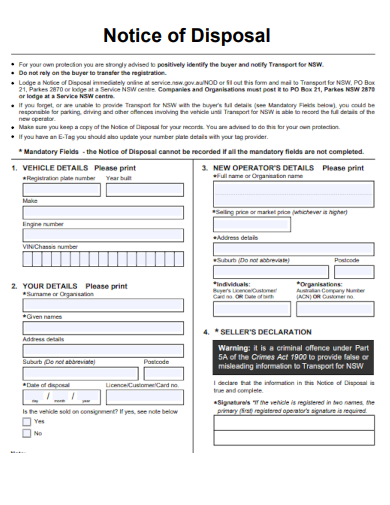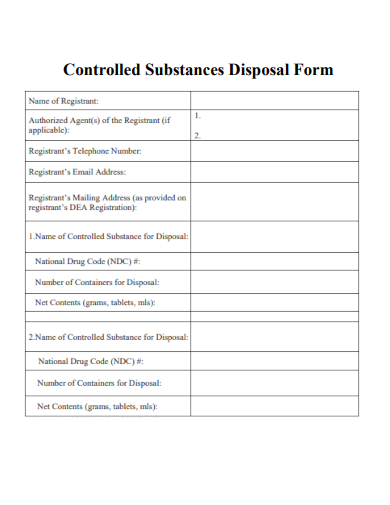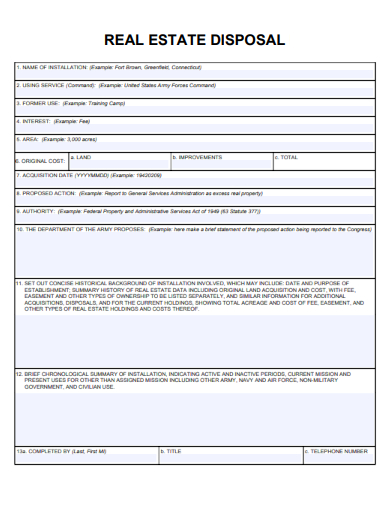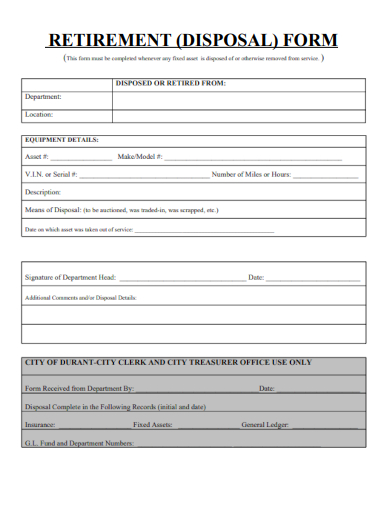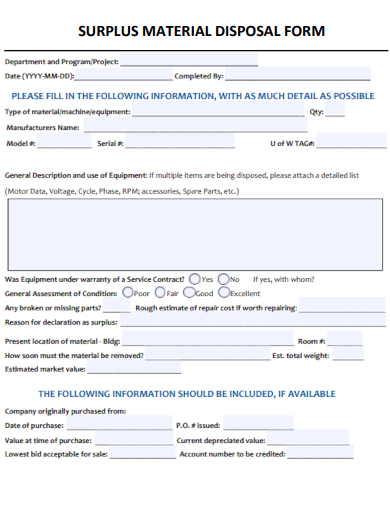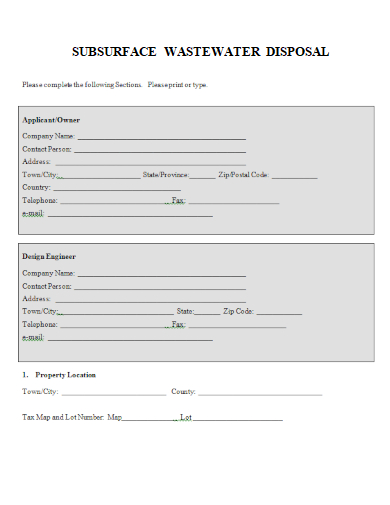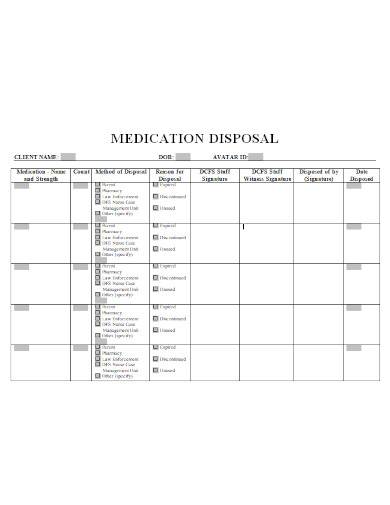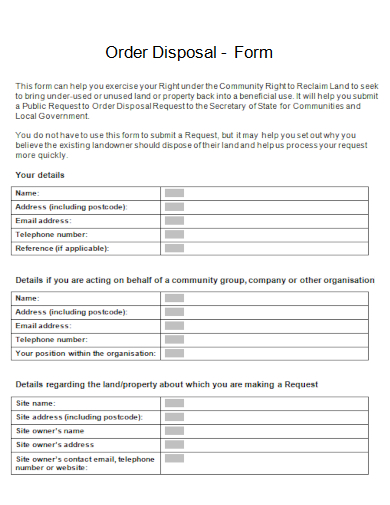A disposal form is an essential administrative tool that helps in simplifying the process of discarding assets, materials, or information while remaining compliant with legal, ethical, and environmental standards. This form provides a structured method for managing disposals and enhancing a company or organization’s asset management plans and compliance efforts. In cases where disposal forms are not the most appropriate document to use, companies can other documents such as inventory adjustment forms, asset transfer forms, deaccession forms, certificates of destruction, surplus property forms, recycling reports, environmental impact assessments, and more.
FREE 36+ Disposal Form Samples
1. Sample Disposal Form Template
2. Sample Property Disposal Form Template
3. Sample Asset Disposal Form Template
4. Sample Equipment Disposal Form Template
5. Sample Waste Disposal Form Template
6. Sample Inventory Disposal Form Template
7. Sample Computer Disposal Form Template
8. Sample Disposal Determination Approval Form Template
9. Sample Disposal Records Form Template
10. Sample University Disposal Form Template
11. Sample Proof of Disposal Form Template
12. Sample Debris Disposal Form Template
13. Sample Disposal of College Property Form Template
14. Sample Tank Disposal Form Template
15. Sample Laser Disposal Form Template
16. Sample Construction Disposal Form Template
17. Sample Disposal Log Form Template
18. Sample Disposal of an Industrial Form Template
19. Sample Product Disposal Form Template
20. Sample Business Disposal Form Template
21. Sample Redeployment & Disposal Form Template
22. Sample Disposal Registration Form Template
23. Sample Disposal of Mobile Form Template
24. Sample Surplus and Disposal Report Form Template
25. Sample Coolant Disposal Form Template
26. Sample Care Provider Drug Disposal Form Template
27. Sample Heavy Machinery Disposal Form Template
28. Sample Notice of Disposal Form Template
29. Sample Controlled Substances Disposal Form Template
30. Sample Real Estate Disposal Form Template
31. Sample Laboratory Disposal Form Template
32. Sample Retirement Disposal Form Template
33. Sample Surplus Material Disposal Form Template
34. Sample Disposal Form Blank Template
35. Sample Surface Wastewater Disposal Form Template
36. Sample Medication Disposal Form Template
37. Sample Order Disposal Form Template
What is a Disposal Form?
Disposal forms are also referred to as disposal request forms or disposal authorization forms. These documents are used to efficiently manage the proper and regulated disposal of materials, assets, or information within a company or organization. A disposal form contains an outline of the necessary information and procedures required to ensure the safe and efficient removal of items from the company’s inventory or records. Other tools or templates that organizations can use are property forms, DOT physical forms, waste management business plans, cleaning checklist templates, and fleet management proposals.
How to Create a Disposal Form
Disposal forms usually contain information like the description of the asset or material to be removed or disposed of, its condition at the time, the reason for its disposal, and the method of disposal which can be to resale, recycle, donate, or destruct. Depending on the asset’s nature, a disposal form might include specifications on any potentially hazardous components and the safety measures required to be taken during its disposal.
Step 1: Collect the Necessary Details
Collect necessary information about the asset or material that is intended to be disposed of. You can include the item’s description, condition, quantity, and unique identifiers like serial numbers. You also have to identify the reason for the item’s disposal and whether it contains sensitive data so you can note its need for data destruction.
Step 2: Provide a Definition of the Disposal Method
Determine the most appropriate disposal method for the item which can be recycling, reselling, donation, or secure destruction. Choose the method that aligns with your company policies, regulatory requirements, and environmental considerations.
Step 3: Start Creating the Disposal Form
Create a clear and comprehensive template for your disposal form, including fields for the asset’s information, disposal method, justification, and the name of the person in charge of the disposal process.
Step 4: Establish an Approval Workflow
Implement an approval workflow that secures the proper authorization for the item’s disposal. Depending on the structure of a company, an approval workflow might involve routing the form to different stakeholders for review and approval. Once approved, the disposal method will be initiated while documenting its process for future reference.
FAQs
What are the commonly used types of disposal forms?
There are various types of disposal forms, created for specific purposes, industries, and purposes. These are asset disposal forms, electronic waste disposal forms, hazardous waste disposal forms, document disposal forms, and surplus property disposal forms.
What is the basic outline of a disposal form?
The basic outline of a disposal form includes a header, requester information, asset or item details, reason for disposal, disposal method, data handling, environmental considerations, approval workflow, disposal date and location, and documentation and records.
What are the main reasons why companies use disposal forms?
Disposal forms are used by companies to ensure their regulatory compliance, transparency and accountability, inventory management, risk mitigation, data security and privacy, environmental responsibility, workflow streamlining, documentation for auditing, consistent processes, and archival and reference.
A disposal form serves as a formal request from a responsible party within the organization to initiate the disposal process for an asset, information, or material. This process often requires the approval of relevant stakeholders or departments before proceeding to the actual disposal of the item. This helps in preventing unauthorized or improper disposal of assets and ensuring that the decision aligns with the organization’s policies and goals.
Related Posts
FREE 20+ Property Agreement Samples in MS Word Google Docs ...
FREE 15+ Expense Report Samples in PDF MS Word | Excel ...
FREE 45+ Transaction Form Samples in PDF MS Word
FREE 5+ Travel Feedback Form Samples in PDF
FREE 8+ Sample Material Lists in MS Word PDF
FREE 10+ Fleet Management Proposal Samples [ System, Project ...
FREE 10+ Sample Quotation Forms in MS Word PDF
FREE 9+ Service Quotation Samples in PDF
FREE 21+ Sample Tea Party Invitation Templates in MS Word PSD ...
FREE 48+ Examples of Survey Forms in MS Word PDF
FREE 35+ Risk Assessment Form Samples in PDF MS Word
FREE 10+ Bulk Sale Notice Samples and Templates in PDF MS Word
FREE 11+ Sample Parts Order Forms in MS Word PDF
FREE 28+ Cleaning Checklist Samples & Templates in PDF MS ...
FREE 40+ Sample Requisition Forms in PDF

